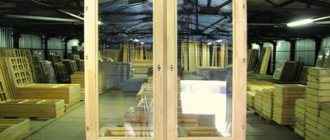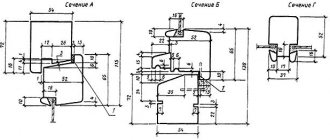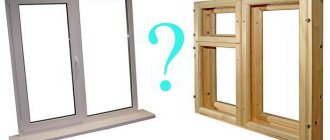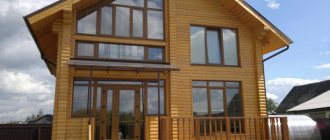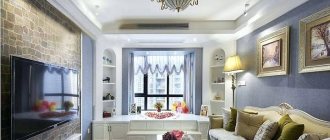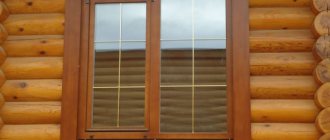For the construction of such buildings, a masonry plan is first developed, which involves laying out the facing bricks in such a way as to minimize the trimming of piece materials.
The most complex element in such structures is considered to be the window opening, since both the partitions and the windows themselves must have dimensions that are multiples of the length or width of the brick.
What documents establish the requirements?
The dimensions of window structures in residential multi-storey and private buildings are established by the following regulatory documents:
- GOST R 56926-2016 “Window and balcony structures for various functional purposes for residential buildings.”
- GOST 23166-2021 “Window and balcony translucent fencing structures. General technical conditions".
- GOST 30674-99 “Window blocks made of polyvinyl chloride profiles. Technical conditions".
- GOST 23166-99 “Window blocks. General technical conditions".
- SP 15.13330.2012 “Stone and reinforced masonry structures.”
These regulatory documents are updated editions of Soviet GOSTs and SNiPs , which have been used in the construction of standard housing since the middle of the last century.
Provided that each ]window blocks[/anchor] is guided by the above standards, this imposes on the construction participants the responsibility for the correct installation of brickwork to ensure the required geometric parameters of openings in the external walls.
In the case when we are not talking about standard housing, window blocks are made on the basis of pre-made measurements, since when arranging openings, errors may occur. This ultimately leads to time-consuming and costly custom order processing.
Rule 1. What criteria should a window meet?
For those homeowners who want to install window openings in their future home in accordance with GOST, I recommend that you familiarize yourself with the regulatory and technical document GOST 23166-99 “Window blocks. General technical conditions". At the same time, I would like to warn you right away that this document contains a lot of specialized technical information, which in most cases may turn out to be incomprehensible and useless for many private developers.
Scheme of window blocks from GOST 23166-99.
So that the reader does not rack his brains over this issue, I will then try to explain in an accessible language the main provisions of the current State Standard for windows:
- When choosing technical characteristics for a future window opening, first of all, you need to be guided by the room in which the window will be located and for what purposes it will be used;
- The total glazing area of one or more window openings must ensure free transmission of the required amount of natural sunlight , which should be sufficient to avoid the use of artificial lighting during daylight hours;
- All dimensions of window openings according to GOST are, in principle, standardized, however, in accordance with current standards, they can vary within fairly wide limits. Therefore, in the next section I plan to pay more attention to this issue.
The diagram shows standard sizes for single and double sash windows.
- Sound insulation class, air permeability and water resistance class, light transmission coefficient, heat transfer resistance value, and sound insulation value must be within the established limits of this regulatory and technical document;
- The estimated service life of wooden and plastic frames must be at least 20 and 40 years, respectively, the service life of fittings and double-glazed windows must be at least 20 years, and the service life of a set of rubber seals must be at least 5 years.
- The number of opening/closing cycles of swing or sliding sashes, while maintaining normal operation, must be at least 20,000.
The diagram shows standard sizes for three-hung windows.
During the design and construction of a house, I recommend using standard sizes of window openings for plastic windows, since manufacturing double-glazed windows of irregular shape or non-standard sizes can be much more expensive.
Rule 2. Typical sizes of window openings in apartment buildings
Window and door openings in apartments of multi-storey buildings are part of the external load-bearing walls of the building, therefore changing their dimensions or making any other changes to the design is strictly prohibited by the current Construction Norms and Rules (SNiP). At the same time, to replace or install new windows, homeowners need to know at least the approximate size of the external glazing in all rooms of the apartment.
Schematic representation of a single-hung, double-hung and three-hung window.
In most cases, each type and each series of multi-story buildings have standard windows, and to make it easier for the reader to navigate, below I will give approximate sizes of window openings in typical residential apartments:
- Houses of the old housing stock, built at the beginning of the last century, are distinguished by elongated rooms, thick walls and high ceilings , so the window openings in such houses most often have a rectangular vertical shape and are quite large in size:
- In such apartments, the width of a single-leaf window can range from 850 to 1150 mm, and the height on average is about 1900 mm, but sometimes can reach 2100 mm;
- The two sashes usually have the same height, but their width can be from 1200 to 1500 mm;
- Triple-hung windows are rare, but their maximum dimensions can reach 2400x2100 mm.
The characteristic shape of windows for old housing stock.
- The so-called “Stalinist houses”, which were built from the 30s to the 60s of the last century, in addition to high ceilings, are distinguished by large and spacious rooms with a separate layout , so single-leaf windows in such apartments are almost never found:
- Double-leaf windows have two standard sizes: 1150x1950 mm, and 1500x1900 mm;
- For three-leaf windows at that time there was one standard - 1700x1900 mm.
Typical windows of Stalin-era houses.
- Typical five-story residential buildings, which were built from the early 50s to the mid-80s of the last century, are usually called “Khrushchev buildings” . They have cramped, uncomfortable layouts with small kitchens and small walk-through rooms, and the standard ceiling height is no more than 2500 mm. For the manufacture of windows in such apartments, two standard sizes were used, and they can be easily determined even without a tape measure, by the shape and width of the window sill:
- If the window has a wide, massive window sill, then its dimensions are, for a double-leaf opening - 1450x1500 mm, and for a three-leaf opening - 2040x1500 mm;
- In apartments with a narrow window sill, which practically does not protrude beyond the plane of the wall, the dimensions of double-leaf and three-leaf windows are 1300x1305 mm and 2040x1350 mm, respectively.
Typical facade of a Khrushchev five-story building.
- Newer "Brezhnevka" apartments were built in the 70s and 80s, along with the "Khrushchevka" apartments, and their main positive difference is the improved layout and larger kitchen area . Typical designs of such houses have several series, and in each series the window sizes are slightly different:
- Of all the “Brezhnevka” windows, the 600th series is distinguished by the largest windows, since in such apartments the double-leaf opening has dimensions of 2380x1420 mm, and the three-leaf opening has dimensions of 2690x1420 mm;
- In the 602 series, the double-leaf window has a size of 1210x1450 mm, and the three-leaf window has a size of 2100x1450 mm;
- The 606th series has the smallest windows: double-leaf - 1450x1410 mm, and three-leaf - 1700x1410 mm.
The photo shows a Brezhnev house with larger windows.
- Modern new buildings are considered to be apartment buildings that were built from the 90s of the last century to the present. Typical designs of modern houses are presented in more than 40 different series, so I will give the sizes of window openings for several of the most common standard series:
- 137th series two doors - 1150x1420 mm, three doors - 1700x1420 mm;
- 504th series two doors - 1450x1410 mm, three doors - 1700x1410 mm;
- 504D series two doors - 1420x1100 mm, three doors - 1420x2030 mm;
- 505 series two doors - 1410x1450 mm, three doors - 1410x2030 mm;
- 600.11 series two doors - 1410x1450 mm, three doors - 1410x2050 mm;
- The 600D series has only two sashes, and in this case the dimensions of the window openings can be 1420x2680 mm, 1100x2360 mm or 1420x2360 mm.
In modern new buildings you can often find three-hung windows.
I would like to remind you that all dimensions presented are approximate and are intended to provide an approximate estimate of the cost of manufacturing new windows. I strongly do not recommend using the specified values when ordering window frames, since in each specific case, all measurements for a plastic window must be carried out directly at the installation site.
Rule 3. Sizes and location of windows in private houses
When designing and building private houses, I advise choosing the size and shape of window openings taking into account the requirements of the same regulatory document GOST 23166-99 “Window blocks. General technical conditions". At the same time, I should note that private developers have more room for maneuver, since this document does not establish any strict boundaries and restrictions:
- In order not to disrupt the conceptual style of the residential building project, when developing the size and number of window openings, you need to take into account the height of the ceilings, the total number of floors, the area and width of each room, as well as other architectural features of the building;
The external decoration and shape of the windows shapes the appearance of the façade.
- The optimal height and width of windows should be determined based on the total area of the room and the required level of illumination;
- The glazing area and standard sizes of window openings in private houses are regulated by SNiP P-A862. According to the requirements of this standard, in living and sleeping areas the total area of the light opening must be at least 1/8 of the total area of each room ;
- For glazing of non-residential and utility premises, these dimensions in a private house can be reduced up to 4 times. Thus, in a toilet, bathroom, storage room or boiler room, the window area can be no more than 3% of the total area of the room ;
A modern metal-plastic window for a country house with imitation stained glass.
- In regions with a cold climate and short daylight hours, it is best to orient the windows towards the south or southwest side of the house;
- In hot climates with a large number of sunny days a year, to reduce the influence of the sun on the internal microclimate, windows should be located on the north or east side of the house;
- The ease of use and functional qualities of windows in various rooms largely depend on the height at which the window sill is located relative to the level of the finished floor. From my own experience, I recommend using the following values:
- In the living room, bedroom or children's playroom, the optimal height from the floor level to the window sill is 700-900 mm . This size provides a good panoramic view and the most efficient transmission of natural sunlight;
- For a kitchen, the height of the window sill can be from 800 to 1200 mm . This is due to the fact that the window sill should be located on the same level as the sink and kitchen countertops;
A wide window in the kitchen with a panoramic view of the forest clearing.
- In a toilet, bathroom or bathhouse, the height of the window sill is usually made at least 1600 mm . This is done in order to provide high-quality natural ventilation, and at the same time make it as difficult as possible for strangers to spy on residents during intimate procedures;
- On insulated balconies, verandas and closed summer terraces, the window sill board should lie on top of the side railing, and its height can range from 700 to 1100 mm.
- In utility and utility rooms, the light opening is usually made in the form of a low window or a wide horizontal window , which is installed at a level of 1600-1800 mm from the floor.
An original panoramic window with a beautiful view from the bathroom.
When choosing where to install windows in a country house, I advise you to pay attention not only to technical aspects, but also to the aesthetic side of the issue. There are no trifles in this matter, for example, neat, beautiful brickwork and stylish exterior decoration of window openings have a significant positive impact on the appearance of the facade, and on the aesthetic appearance of the entire house as a whole.
Rule 3. Features of the installation of window openings in a brick house
To install a window in the wall of a brick house, in accordance with the technical design, starting from a given height, several rows of bricks are not laid, as a result of which a window opening is formed in the brickwork.
In order not to go into the technical details of the work of masons, below I will talk about what a quarter is in a window opening, what it is used for, and how to make an opening for a wooden or metal-plastic window in a brick house.
- I want to say right away that the width of the opening on the inside of the house should always be made several centimeters wider than the design dimensions of the window frame . Thus, in the top view, a ledge is formed in the side walls, which is called a quarter;
The diagram shows the installation of a window in a brick opening with a quarter.
- During installation, a wooden or plastic window frame is installed from the inside of the house into the extension of the slope , and its front part rests against the rear edge of the quarter;
- This ensures high-quality thermal and waterproofing of the window. This is achieved due to the fact that cold wind and slanting rain from the street will not be able to directly penetrate into the gap between the outer slope and the window frame.
- After the laying of the side walls is completed, it is necessary to lay the top floor of the window on the top row of bricks. It is a horizontal lintel, which must bear the load from all other rows of bricks and ceilings located above the window opening;
- A thin reinforced concrete beam with a width of 250-300 mm, a metal channel or a thick-walled steel angle with a cross-section of at least 120x120 mm is most often used as a lintel.;
If there is no ready-made concrete lintel of suitable size, it can be poured on site from monolithic reinforced concrete.
- The main disadvantage of steel lintels is that the metal has high thermal conductivity, so so-called cold bridges are formed above the windows. To minimize the likelihood of low temperatures entering the house, decorative finishing on the outside of the house should be made using thermal insulation materials;
- The lintel must be of such length that, after installation, it completely covers the window opening and extends over the top of the side brick walls by at least 100 mm on each side.;
- After installing the lintel, I advise you to once again check the size of the window opening, and then proceed to further laying the next rows of bricks above the window opening;
- Installation of window blocks, sealing of remaining cracks and finishing inside is usually done at the very end, after the entire house has been built and the roof has been installed, so I plan to talk about installing windows separately in the next article.
Wooden jig for laying an arched brick lintel.
To make an arched window of a semicircular or oval shape with your own hands, I recommend using two metal corners or a channel of a suitable cross-section as a ceiling. To do this, you need to make many deep slits at a distance of 50-100 mm from each other in one of the shelves of each corner, or in two narrow shelves of the channel, using a grinder. After this, it will be easy to bend any profiled metal into an arc along the required radius.
Rule 4. Arranging a window opening in a house made of aerated concrete
The manufacture of window openings in an aerated concrete house is generally carried out according to the same principles as in brick houses. The exception is the load-bearing elements and the upper horizontal lintels, since they are cast from monolithic reinforced concrete directly at the installation site.
- For the manufacture of vertical load-bearing elements of the house, special hollow aerated concrete blocks are used . After they are installed on top of each other, a vertical cavity in the form of a well is formed inside them;
A lintel made of steel corners in an aerated concrete house without an armored belt.
- Such blocks perform the functions of permanent formwork . A reinforcement frame is installed inside the resulting well, and then liquid concrete solution is poured to the very top;
- After the concrete solution hardens, a monolithic reinforced concrete column is formed inside the aerated concrete blocks, which has a high load-bearing capacity. I recommend initially including such columns in the project, and placing them in the corners of the house, as well as along the edges of wide window and door openings;
- The upper window coverings have a similar internal structure, only U-shaped open-top blocks made from heavy grades of aerated concrete are used as permanent formwork for pouring concrete mortar.
- Inside the finished window opening, you need to install and firmly secure vertical supports from scraps of thick bars or steel pipes;
The upper part of the window opening is made of hollow U-shaped blocks.
- Fix a thick, flat board flat on top of them, and then lay out U-shaped blocks so that with their lower plane they form the upper edge of the window opening;
- You need to lay a reinforcement frame in the resulting hollow gutter, weld its ends to the protruding reinforcement bars of the vertical columns, and then fill the entire gutter to the top with liquid concrete mortar;
- After the solution hardens, a rigid lintel of monolithic reinforced concrete is formed above the window opening, closed on all sides with aerated concrete blocks.
- In aerated concrete houses, the preparation of window openings for the installation of PVC windows can begin only after the final hardening and maturation of the monolithic concrete mixture. Depending on the brand of concrete solution, this period can last from 14 to 28 days.
Reinforced monolithic concrete lintels over windows after pouring concrete mortar.
Aerated concrete has an open, finely porous structure, due to which it strongly absorbs moisture, therefore, under the influence of precipitation, it can crack and collapse over time. To prevent this from happening, I advise you not to waste time, and immediately after construction, carry out protective and decorative decoration on the outside of aerated concrete houses, using hydrophobic, moisture-repellent finishing materials.
Height and width tables
As a rule, designers and property owners strive to build facade walls in such a way as to install window blocks with standard dimensions in the openings. The most common sizes, according to GOST, are described in detail below.
For multi-apartment
Most apartment buildings are designed in compliance with the rules for typing and unifying window openings by size. Thus, when constructing external walls, 3 – 5 standard sizes are used , each of which is standardized by GOST.
Typical dimensions of window units for economy-class apartment buildings built using brick boundary walls can be seen in the following table:
| Window marking | Number of sashes | Availability and dimensions of the balcony door | Window height , mm | Window width , mm | Height of the outer edge of the opening , mm | Height of the inner edge of the opening, mm | Width of the outer edge of the opening , mm | Width the inner edge of the opening, mm |
| OR-15-9 | 1 | — | 1460 | 870 | 1470 | 1510 | 830 | 910 |
| OR-15-15 | 2 | — | 1460 | 1470 | 1470 | 1510 | 1430 | 1510 |
| OR-15-18 | 3 | — | 1460 | 1770 | 1470 | 1510 | 1730 | 1810 |
| OR-15-21 | 3 | — | 1460 | 2070 | 1470 | 1510 | 2030 | 2110 |
| OR-15-9 BR-24-9 | 2 | 870 x 2375 | 1460 / 2375 | 870 + 870 | 1470 / 2370 | 1510 / 2410 | 1770 | 1810 |
| OR-15-12 BR-24-9 | 3 | 870 x 2375 | 1460 / 2375 | 1170 + 870 | 1470 / 2370 | 1510 / 2410 | 2070 | 2110 |
When arranging window openings in a brick wall, one should not forget that their outer dimensions are smaller than the inner ones, thanks to the quarter - the facing brick covers part of the structure , protruding ¼ of its standard length.
For private
For a private home, each owner can choose one of the two most common options for filling window openings with translucent structures:
Order and installation of translucent products with dimensions in accordance with GOST requirements, among the assortment described in the table.- Construction of a residential building in strict accordance with the architectural design, followed by the execution of an individual order. For this procedure, certain steps are followed:
- Measuring window openings.
- Determination of average dimensions.
- Bringing existing structures to one or more modular dimensions.
- Drawing sketches of future windows, determining the number of sashes, as well as their functionality.
- Calculation of specifications for window structures.
- Placing an order with the production and installation company, according to the specifications for the drawings.
It should be noted that the execution of an individual order always costs 15% - 25% more than the production of standardized products, regardless of the design configuration. This is due to the presence on production lines of conductors manufactured for standard products, which greatly facilitates their assembly and, accordingly, affects the retail price.
What is GOST?
In order not to endanger human health and life, not to endanger the environment, plants and animals, as well as to protect public and private property, special standards for goods and products have been developed. The abbreviation GOST is an abbreviation for state standards. The compositions, methods and production technologies they recommended were mandatory requirements until 2011.
Since September 2011, compliance with GOST standards has been made a voluntary procedure. Technical regulations began to form the basis of a new standardization system. But if we are talking about the life and health of people or the preservation of the environment and property, then GOSTs must still be strictly observed. Standard sizes of window openings also fall under the category of mandatory and unchangeable values.
If we are talking about construction work, then, in addition to GOST, when constructing residential buildings, it is customary to focus on one more type of documents. SNiPs are building norms and rules that regulate urban planning activities.
What can be non-standard?
Not all multi-apartment buildings are built according to standard designs . Many residential real estate properties belong to business or premium classes, and some buildings are constructed in the form of multifunctional complexes with a set of non-residential premises in the stylobate part. In such structures, translucent structures may have the following non-standard dimensions:
- The first floors in the stylobate parts, intended to accommodate commercial premises, are made with a height of at least 3600 mm, and window structures are installed with dimensions of 2360 mm or more.
- Many individual projects include panoramic glazing with dimensions up to 2970 x 2970 mm.
- When arranging semi-buried floors in use, in the absence of a light pit, window blocks are installed with dimensions from 570 x 560 to 1170 x 1160 mm.
- The minimum permissible size of a window structure for a brick house is 340 x 340 mm, which corresponds to an opening of 380 x 380 mm.
According to the requirements of GOST 30674-99, the maximum permissible weight of a window unit in a standard reinforced profile cannot exceed 3600 - 4200 mm , depending on the thickness and number of chambers in the frame. In other cases, an individual calculation of structures for strength and flexibility is required, with the installation of additional reinforcing half-timbers.
Dimensions of window openings in typical new buildings
Modern developers are building houses in more than 40 series. Naturally, the width and height of window and door openings will be different. Sometimes the difference is 1-2 cm, but in some cases it reaches more than 20 centimeters. The dimensions are regulated by one general GOST 11214-86, and differences in the height and width of doorways, as well as windows, depend on the area of the room. It is clear that in a spacious room with high ceilings and in a small bedroom, the required level of illumination will be obtained through different openings.
Returning to GOST 11214-86, it should be noted that the recommended window dimensions are 87-267 cm in width and 116-206 cm in height. According to it, in modern new buildings the parameters of doorways fit into two standard widths: 72 and 87 cm.
Table 2. Standard window openings in modern houses
| Series | Double-hung window (cm) | Three-leaf window (cm) |
| 137 | 115 × 142 | 170 × 142 |
| 504 D | 142 × 110 | 142 × 203 |
| 504 | 145 × 141 | 170 × 141 |
| 505 | 141 × 145 | 141 × 203 |
| 600. 11 | 141 × 145 | 141 × 205 |
Why is it important to know the standards?
Knowledge of the standard nomenclature for the dimensions of window openings in brick houses is very important for the following participants in the construction and installation industry and the home owners themselves:
For designers:- Drawing up a correct masonry plan.
- Linking the order on facades to brick dimensions.
- Preparation of specifications using standard sizes, which contributes to the unification of products.
- For installers and masons:
- Possibility of laying bricks in each row with exact observance of the brickwork dimensions.
- Correct design of dimensions of walls and window openings.
- Installation of quarters on the side and top edges of a structural element to fill translucent structures.
- For window block manufacturers:
- Production of standard structures tied to brickwork.
- Unified installation of blocks along the entire wall plane.
- Minimizing production costs, which affects the cost of production.
- For the owner of the property:
- Accurate cost estimate to determine the required investment.
- Possibility of saving money by ordering standardized window units.
- Ease of maintenance of structures.
- Use of standard fittings.
- Acceleration of the installation process, which affects the timing of commissioning of the facility.
If the dimensions of window structures and openings are not observed during the construction of brick masonry, there is a risk of increased investment in construction, as well as a significant increase in installation time.
In addition, if, during the operation of a facility with non-standard design solutions, any of the windows fails, its repair will cause certain difficulties and increased costs.
General information, types of windows
To meet human needs and preserve his health, there are norms, standards and GOSTs for window openings. The essence of these standards is to provide sufficient natural light for people, without subjecting the structure to significant changes and the possibility of its destruction. There are many sizes of plastic windows, suitable only for some openings. If you plan to install a plastic window in the future, it won’t hurt to arm yourself with the opinion of an expert in this matter. Types of window openings by number of sashes:
- single-leaf;
- bivalve;
- tricuspid.
How the opening is prepared
Before performing window installation work, it is necessary to thoroughly clean the opening from dirt and dust. It is important to remove all remaining paint and building materials. Before installation, it is also important to compare the dimensions of the opening and the plastic frame. If the gap is more than 4 cm, it is necessary to use not only foam. This is due to the fact that when using it, it will not be possible to create an even and high-quality seam. In addition, quite a lot of foam will be lost.
Before installation, you must remove the sashes from the frame. To do this, simply pull the pin out of the hinges. If it is necessary to remove a glass unit from the frame, remove the glazing beads holding the glass. These steps must be performed very carefully so as not to scratch the glass.
After removal, the sashes and double-glazed windows should be placed on a soft mat and leaned against the wall so that they are in a stable position. Double-glazed windows should not be laid flat, as this may lead to scratches on the surface of the glass.
After this, the protective film is removed and markings are applied to the places where the fasteners will be located. The distance between them should be about 40 cm. It is important to take into account that the distances from the corners should be more than 15 cm.
Materials required for work
Before you begin installation, you need to prepare the following materials:
- wedges inserted for the correct positioning of windows;
- polyurethane foam;
- sealant;
- water vapor barrier material necessary to protect joints from moisture;
- anchor bolts.
Wedges are used during the installation process to more accurately install the plastic profile. Without these materials it is much more difficult to monitor. Polyurethane foam is an insulating material that fills the space between the wall and the frame. When choosing foam, it must be taken into account that it must correspond to the temperature at which the work will be carried out. If you purchase a material intended for use in the summer, its use in winter may lead to the creation of a poor-quality insulating layer.
You will also need self-expanding sealing tape during work. This material is glued around the perimeter of the window from the outside, after which it expands. Sealant is used to fill the space between the slopes and the window sill.
Design features of plastic windows
Structurally, a plastic window can be:
- blind (without opening doors);
- with parallel-sliding or tilt-and-turn opening;
- one-, two- or three-leaf;
- ordinary, balcony or attic;
- with and without transoms, vents, ventilation valves.
Moreover, regardless of the dimensions of the plastic window, the sashes in it can open in the direction both to the right and to the left. And in form it can be anything at all. Nowadays plastic profiles are bent in a semicircle and semi-oval, and also connected at a wide variety of angles.
Standard designs of plastic windows
Modern technologies make it possible to create a translucent structure for any window opening of any configuration and size. It's like choosing a generator for your home or a drainage pump, you'll have to break your head. There are many options to choose from. And you can order absolutely any window, you just need to find a manufacturer with a suitable price.
Related article: Warranty for plastic windows by law
Design features of plastic windows
Advantages of standard sizes of plastic windows
For an apartment in a high-rise building (it doesn’t matter whether it’s a Khrushchev-era building, a Stalinist building or a panel house), window blocks will have to be taken only to the size of the existing opening. But for a private house, even at the design stage, any window sizes can be specified.
Advantages of plastic windows
However, it is better to give preference to standard sizes. Such window products will be cheaper and easier to install. It is quite possible to install them yourself.
Conclusion
The sizes of plastic windows should be selected exclusively to fit the existing window opening. Deviations of 5–10 cm are unacceptable here; it will still not be possible to seal the voids between the frame and the wall.
Therefore, in terms of design, it is unlikely that it will be possible to develop in a city apartment or in an already built cottage. And for a private house that is just being designed, it is also better to choose standard sizes in order to save money and speed up its construction.
Non-standard products attract attention and emphasize the individuality of the facade. But they will take longer to make than standard options, and they will cost much more.
Watch also the video on how to take measurements of a plastic window:
Standard sizes of plastic windows
Almost all windows currently installed in apartments and cottages are made of PVC plastic. Wooden analogues are gradually disappearing into oblivion; they are often used only as a design sophistication. Plastic is cheaper and more durable. At the same time, the standard window sizes remain the same, regardless of the frame material. This greatly simplifies the replacement of old translucent structures in window openings with new ones.
Related article: How to properly insulate windows for the winter
Metal purlins
Most often, when constructing a brick building, window openings are blocked using a metal channel. This is a convenient and durable material, the installation of which does not take much time. The main thing is to choose the right size of the part; You can cut off the excess on the spot using a grinder. The size is selected as follows: if the partitions are placed in half a brick, the channel should be 120 or 140 mm; if the structure has brick partitions, it is more convenient to use a channel measuring 240 or 270 mm. This will ensure the most comfortable installation and give the structure sufficient strength.
However, when using a metal corner for window openings, you need to take into account that there are some restrictions associated with the load that can be given to the structure. When using a corner, the masonry of the walls and the opening must be firmly connected to each other; in addition, it is impossible to equip purlins of great length.
When installing a purlin from a corner, it should be positioned so that the edges of the metal are in contact with the brick that will be placed on top. The maximum permissible length of jumpers that are created from a corner is 1.5 meters. If the span is larger, the masonry above it will begin to sag due to the metal bending.
Standard window size for residential premises
In a private house
Standards for window openings exist to regulate light in private homes and beyond.
The characteristics of window openings are based on what the room is intended for, but the following is also provided:
- the ability of a window package to transmit light;
- geography;
- dimensions of the building;
- degree of suitable lighting.
Based on building codes, we calculate window standards. In addition, they are designed for cleaning twice a year, and for areas with poor ecology - 4 times a year .
Now they also provide for the number of glasses in the package and the distance between them - for each customer the refractive index of the beam will not be calculated, and the illumination will decrease.
If we take single-leaf windows, then their usual width and height vary from 470X470 mm to 1470X870 mm. Naturally, everything here depends on the dimensions of the opening.
Let's look at double- and triple-hung windows. Windows with two sashes vary from 570X1170 mm to 1470X1470 mm. Window openings with three sashes vary from 1170X1770 mm to 1470X2070 .
Do you know how to make plastic window slopes with your own hands? Details are in this article.
In the apartment
Now let's look at the standards of windows in an apartment panel building. It all depends on the type of house:
- for “brezhnevka” the dimensions of a double-leaf window are 1300x1400 mm, with three sashes - 2100x1400 mm;
- for the “new layout”: with two doors 1460X1430 mm, with three - 1780X1430 mm;
- “Stalinka” is characterized by T-shaped windows, its dimensions can be 1500X1900 mm, 1250X1800 mm and 1080X1800 mm;
- for “Khrushchev”: double-leaf window 1208X1340 mm, three-leaf window - 2040X1500 mm;
- for the “Czech”: with two doors 1300X1400 mm, with three - 1760X1400 mm.
Optimal window sizes in different parts of a country house
Some rooms in a country cottage require more natural light, others less.
Glazing of residential areas
The optimal window sizes for a private home determine the viewing angle that opens to the owner from the kitchen and bedroom. The size of glass structures affects the organization of heating. If the window height is from floor to ceiling, it will be necessary to install additional radiators or a “warm floor” system. Note that cottage owners often prefer large panoramic windows.
A large glass area is installed for the bedroom, kitchen, and living room. Choose two- or three-leaf structures of standard dimensions. Consider the arrangement of furniture: desk and bed in the nursery, cooking area in the kitchen. Provide the optimal distance for opening the doors and comfortable cleaning.
Technical rooms
The bathroom, pantry, and boiler room need less light. In the bathroom and toilet, glazing does not require compliance with a clear standard. Therefore, the size of the window in the bathroom of a private house depends on the preferences of the owners. In some cottages, small frames from 50x50 cm are installed. In others, high frames of 120x90 cm with a matte finish are installed. If small windows are inconsistent with the architectural design, install full-fledged structures with 1 or 2 sashes.
For the glazing of a gas boiler room in a private house, regulatory requirements are put forward. They are specified in GOST R 56288-2014 and SP 402.1325800.2018 and are carried out by construction organizations.
When choosing the size of a window in a gas boiler room or utility rooms of a house, pay attention to square models with a side of 50, 60 cm with a window.
Ladder
As for the glazing of a flight of stairs, there are no strict rules for glazing. Follow the standard requirements for the placement of plastic windows in a wooden, brick, or block house. Large panoramic windows provide a beautiful view from the country cottage and bright lighting. But if they are directed towards the street, they will attract the attention of passers-by.
GOST parameters and requirements
According to GOST 23166-99, an ordinary standard window in a residential building should not exceed 6 sq.m. in area. And the square footage of the door opening in it is limited to 2.5 sq.m. Anything beyond these dimensions is not a GOST product and requires separate certification for safety and reliability.
Comparison of heat loss in a house with conventional windows and double-glazed windows
This standard also provides for the classification of plastic and other windows (window blocks) according to:
- light transmittance;
- soundproofing;
- air and water permeability;
- resistance to wind load;
- heat transfer resistance;
- resistance to climatic influences.
The last of the listed parameters divides plastic windows into two types - with normal and frost-resistant versions. The remaining indicators have five main classes (from “A” to “D”), where “A” is the best.
Energy efficiency of plastic double glazing
According to the Gost convention, these letters are written below the line. At the top, the size of the window, the material of the frame, the presence of sashes and other design features of the product are indicated. All this is written down in the passport for the window unit.
Keeping your home warm with energy-saving plastic windows
Dimensions of panel building frames
Multi-storey buildings appeared in our country earlier than panel buildings, which began to be built during the Khrushchev period. In such houses, the frames usually have two or three sashes, and the balcony opening is equipped with a door and 1 blind window. The usual window opening width is 1500 mm, the number of sashes for this size is determined from the ease of glass maintenance and symmetry rules - these are 2 movable glass panels. If the size is more than one and a half meters, order a window with 3 sashes. In panel houses of different periods of construction, window sizes have some differences:
- The standard dimensions in Khrushchev-era apartment buildings depend on the width of the window sill - it can be narrow or roomy. In the first case, the window is double-leaf with dimensions 1350x1300 and 1500x1450 mm. The second option is a three-leaf frame with a height of 1350 or 1500 and a width of 2040 mm.
- The dimensions of openings in five-story Brezhnev houses no longer depend on the number of rooms in the apartment: the dimensions for a double-leaf window are 1400x1300, for a three-leaf window - 1400x2100 mm. Fixed glazing of the window block of the balcony door 1400x1400.
- The dimensional sizes of frames in apartments of modern high-rise buildings are numerous and differ in each of the series, of which there are more than 40. Today, plastic windows in buildings are installed during the construction stage.
The new building also involves the installation of a PVC balcony door. GOST prescribes the height of the canvas 2150−2160 mm, width 670−750. The horizontal size of the windows on the balcony is 570−1400, their height is 1400−1420 mm.
Is there a standard for PVC windows?
The technology for producing plastic windows does not limit the manufacturer in size and shape. Non-standard window openings are successfully glazed with PVC structures. Certain nuances exist, but they are related to the design features of the window, the profile capabilities and the weight of the glass unit.
For example, even blind sashes with an area of more than 1 m² are not recommended to be made without an impost. The profile of such glass will withstand, but under its own weight it will sag and collapse.
For pivoting sashes, a proportion must be observed, according to which the height should be significantly greater than the width. Otherwise, even the most durable fittings will not work.
With all the numerous possibilities that manufacturers of PVC structures claim, it should be remembered that any deviation from the standard sizes or shapes of window openings inevitably leads to an increase in the cost of the product. Therefore, standard window models for both private and apartment buildings will always cost much less.


